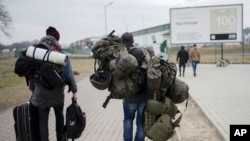The Russian Defense Ministry reported that its forces killed more than 200 “foreign mercenaries” and wounded more than 100 others during the first three days of 2023.
On January 2, Russian Defense Ministry spokesman Lieutenant Gen. Igor Konashenkov said:
“As a result of strikes by high-precision weapons of the Russian Aerospace Forces on the temporary deployment points of ‘Foreign Legion’ units in the areas of the settlements of Markovo [and] Kramatorsk [in] the Donetsk People's Republic, as well as Novoosinovo [in] the Kharkiv region, more than 70 foreign mercenaries were killed, more than 100 wounded.”
On January 3, TASS quoted Konashenkov as saying there had been more such strikes:
“More than 130 foreign mercenaries were destroyed by high-precision strikes of the Russian Aerospace Forces [on] the temporary deployment points of the Foreign Legion units in the areas of the settlements of Maslyakovka and the city of Kramatorsk [in] the Donetsk People's Republic.”
The ministry’s numbers are likely false.
First, it did not provide any details or evidence to back up its numbers. Second, international media have not reported such massive casualties.
Ukraine says more than 20,000 foreign volunteers from some 52 countries have answered President Volodymyr Zelenskyy’s call to come and help Ukraine fight Russian forces since Russia launched its full-fledged invasion last February.
“Russian claims of hundreds of foreign volunteers killed daily are absurdly high,” said Chuck Pfarrer, a former U.S. Navy Seal and author of “SEAL Target Geronimo: The Inside Story of the Mission to Kill Osama Bin Laden,” a New York Times bestseller.
Polygraph.info asked Pfarrer, who closely monitors the situation in Ukraine and maintains contacts with the Americans and other foreign volunteers fighting there, to assess the Russian Defense Ministry’s claims about the death toll among the international volunteer troops in Ukraine.
“International volunteers make up only about 6% of Ukrainian forces—and a significant percentage of international volunteers do not serve in front line units, but in other capacities. About five-to-10 international volunteer casualties are reported on social media per week — and reported casualties are three times as likely to be wounded as killed,” Pfarrer said.
The Russian Defense Ministry’s claims followed a devastating New Year’s Day HIMARS strike by Ukrainian forces in the town of Makiivka. Ukraine said that strike killed some 400 Russian troops.
The Russian Defense Ministry confirmed the strike the following day and said it had killed 63 Russian troops. On January 4, the ministry raised the death toll to 89 troops.
On January 1, Reuters reported that while it couldn’t verify how many Russian troops were killed in the Makiivka attack, the Russian Defense Ministry’s numbers have been challenged by Russian journalists and lawmakers, who insisted the real death toll was higher.
Considering the backdrop of the Makiivka attack, “General Konashenkov might be engaging in revenge fantasies” by claiming that hundreds of foreign volunteers fighting in Ukraine were killed during January 2-3, Pfarrer said.
“Official Russian accounts of Ukrainian / international casualties are suspect because an accurate count would presume that Russia had captured significant swaths of territory, second, that Ukrainian soldiers had abandoned their dead on the battlefield and third, that recovered bodies carried passports or other documents to indicate that they were foreign volunteers,” Pfarrer said.
“Russian gains have been small, and Ukraine has been scrupulous about recovering their dead and wounded. Russia’s claims are greatly exaggerated,” he noted.
The Russian Defense Ministry has previously made similar overstated claims about strikes on foreign volunteers fighting in Ukraine.
On December 24, Konashenkov claimed Russian troops in Ukraine had killed 150 foreign volunteers. On November 25, he asserted that more than 100 foreigners were killed, and before that, on August 9, he said 335 foreigner volunteers were killed. None of these casualty figures have been confirmed independently.
In March, Russia claimed it had killed 180 foreign volunteers in a single attack on a training camp in Yavoriv. The New Yorker magazine reported the attack was indeed a “bloodbath” that killed Ukrainian troops, but not foreigners.
Harvard International Review reported that most foreigners fighting in Ukraine are doing so for ideological reasons, not for the money. And, unlike the mercenaries of Russia’s Wagner private military company, Ukraine’s international defenders are embedded with the Ukrainian army as a foreign legion, and some units are even integrated with regular Ukrainian troops.
“The contract that international fighters sign with the government in Kyiv makes them Ukrainian soldiers and grants them the same benefits accorded to local troops: medical care, a base salary of about $1,200 a month [with additional pay for hazardous duty], and legal-combatant status under the Geneva Conventions,” The New Yorker reported on December 26, 2022.
Russia routinely brands the foreign volunteers fighting in Ukraine as “foreign mercenaries” in order to exclude them from the protections guaranteed under the 1949 Geneva Conventions, Harvard International Review reported last September.





